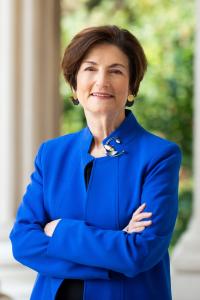
What We All Can Do to Realize the Promise of Our Longer Lives
Dean Linda P. Fried is co-author of a book chapter examining the challenges and opportunities of longevity in the U.S. through the lens of public health and policy
Americans are living longer lives, yet they often live those “extra” years in poor health. In a new book, Law and the 100-Year Life: Transforming Our Institutions for a Longer Lifespan, leading scholars across disciplines explore the possibility of a “third demographic dividend,” a new period of productivity following middle age, and the potential for law and policy to support older Americans.
Dean Linda P. Fried, a leading scholar of aging and director of the Robert N. Butler Columbia Aging Center, is a co-author of a chapter examining the challenges and opportunities of longevity in the U.S., as it relates to public health and the health system. Her co-authors are Abbe R. Gluck, the Alfred M. Rankin Professor of Law and founding Faculty Director of the Solomon Center for Health Law and Policy at Yale Law School, and Top of FormBottom of FormYaron Covo, senior research fellow at Yale’s Solomon Center.
Law and the 100-Year Life is co-edited by Gluck, along with Anne L. Alstott, the Jacquin D. Bierman Professor at Yale Law School, and Eugene Rusyn, associate research scholar in law and a senior academic fellow with the Solomon Center. The book is published by Cambridge University Press and is available through Open Access.
In the chapter by Dean Fried and co-authors, the scholars note that the American health system faces tremendous challenges related to population aging, including impoverished public health agencies, a small and under-compensated geriatric workforce, limited funding for long-term care, and the prevalence of ageism among medical professionals.
They offer a range of policy recommendations for investing in a public health system that can increase the health span for the whole population and improve geriatric care and health systems. Among their proposals are investments in community-based public health programs aimed at increasing physical activity, eating healthy foods, and not smoking, as well as increasing social connection and engagement.
While these investments are needed, in recent decades, the U.S. has decreased its share of public health spending relative to total health spending. A key factor, the authors argue, is the way federal legislation is scored for budget purposes. It is challenging to quantify upfront, as federal law requires, the short-term returns on investments in public health infrastructure. “Relatedly, the longer timeline for returns on investments in public health often does not sync with election cycles and political arguments,” they write.
The chapter’s authors propose several policy solutions to bring about investments in prevention, including utilizing tax benefits and reimbursement structures to incentivize health-care providers to incorporate individualized prevention into patient care.
Another promising avenue can be found in volunteer programs like Experience Corps, which Dean Fried developed to connect senior adults with students in public elementary schools who need assistance in reading and other aspects of academic performance. The program, which is already operating in 20 cities across the country, has shown benefits for both groups. Young people develop improved reading skills, while senior volunteers benefit from human interaction and the positive impact they’re making, with demonstrated improvements in cognition, mental health, and physical strength.
“If we find the ways to incorporate health into older adults’ so-called extra years, older adults will be able to use their experience and expertise to contribute to society by engaging in work, volunteering, leadership, and advocacy activities. Perceived this way, longevity can have ripple effects that have the potential to create a long-lived society in which all ages can thrive,” the authors conclude.
